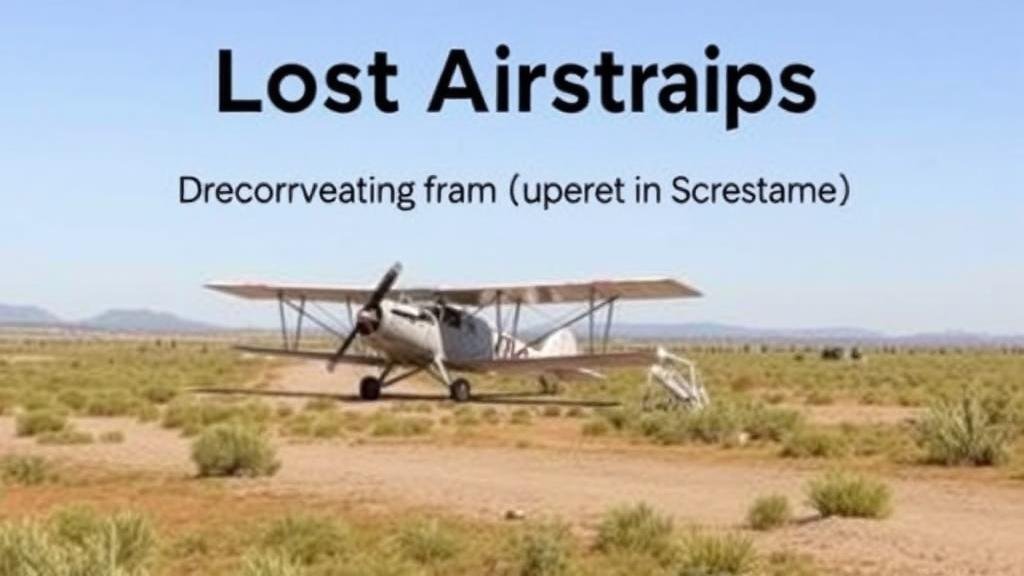Lost Airstrips: Discovering Relics from Early Aviation Pioneers
Introduction
The history of aviation is rich with tales of innovation, exploration, and the indomitable spirit of pioneering individuals. Among the relics that bear witness to this transformative era are lost airstrips, forgotten landing sites that played a crucial role in the advancement of early flight. In this article, we explore the significance of these airstrips, their historical context, and the implications of their rediscovery.
The Emergence of Early Aviation
The early 20th century marked a pivotal period in aviation history. Wright brothers historic flight at Kitty Hawk, North Carolina, on December 17, 1903, ignited public interest and established a foundation for future aviation endeavors. With the advent of World War I, military applications of aviation prompted rapid advances in aircraft design and operational tactics, leading to the establishment of numerous airstrips across the globe.
Military Contributions
During World War I (1914-1918), airstrips were essential for launching aerial reconnaissance and engaging in combat. For example, the Royal Flying Corps set up temporary airfields in France, which were vital for supporting ground troops. e early military airstrips were often constructed with hastily laid materials, making them vulnerable to the elements and subsequent neglect.
Civil Aviation Development
Post-war, the civil aviation industry burgeoned, fueled by the need for commercial air travel and mail delivery. The establishment of more permanent airstrips took hold, but many of these facilities have since fallen into disrepair or been overshadowed by larger airports. Notable airstrips of the era, such as the Cleveland Hopkins Airport in Ohio, opened in 1925 but were once accompanied by smaller, now-lost airstrips that facilitated regional travel.
Significance of Lost Airstrips
Lost airstrips serve not just as historical markers but as critical sites for archaeological investigation. Each site provides insights into aviation technology of the past and highlights how early aviators approached the challenges of flight.
Historical Value
Many lost airstrips have important connections to significant figures in aviation history. For example, the abandoned airstrip on North Captiva Island, Florida, was a training ground for some of the early aviators of the 1920s. Rediscovering such locations helps reconstruct the legacy of these pioneering pilots and their contributions to the field.
Archaeological Insights
The study of lost airstrips can provide valuable archaeological insights. In some cases, professional archaeologists have utilized ground-penetrating radar technology to uncover remnants of old runways and support structures. This non-invasive method allows researchers to map out historical airstrips without significant excavation, preserving the integrity of the site while providing essential archaeological information.
Case Studies of Rediscovery
The rediscovery of lost airstrips has occurred in various regions around the world, demonstrating the enduring legacy of early aviation.
Case Study 1: The Duxford Airstrip
Located in Cambridgeshire, England, the Duxford Airstrip was established in 1918. Originally an RAF base, it is now a historic airfield and home to the Imperial War Museum Duxford. Archaeologists and history enthusiasts continue to investigate the site, uncovering elements such as the original runway and support buildings, contributing to our understanding of military aviation history.
Case Study 2: The L-12 Airstrip in Alaska
The L-12 Airstrip, located in the remote regions of Alaska, served as a critical landing zone during the early years of transpolar aviation. In 2020, a team of historians and archaeologists located the remnants of this airstrip, previously thought forgotten. Artifacts recovered from the site, including aircraft components and personal items from aviators, have been crucial in piecing together the operational history of early Arctic flights.
Conclusion
As we unearth the remnants of lost airstrips, we gain invaluable insight into the evolution of aviation and the stories of those who dared to explore the skies. e sites are more than mere historical artifacts; they are testament to human ingenuity and the relentless pursuit of flight. Preserving these sites not only honors the legacy of early aviation pioneers but also serves as a resource for future generations interested in the field of aeronautics.
Actionable Takeaways
- Engagement with local historical societies can lead to discoveries related to lost airstrips in your area.
- Promoting preservation initiatives for historical airstrips can support aviation history education.
- Utilizing modern technologies, such as ground-penetrating radar, can enhance archaeological studies of aviation relics.



